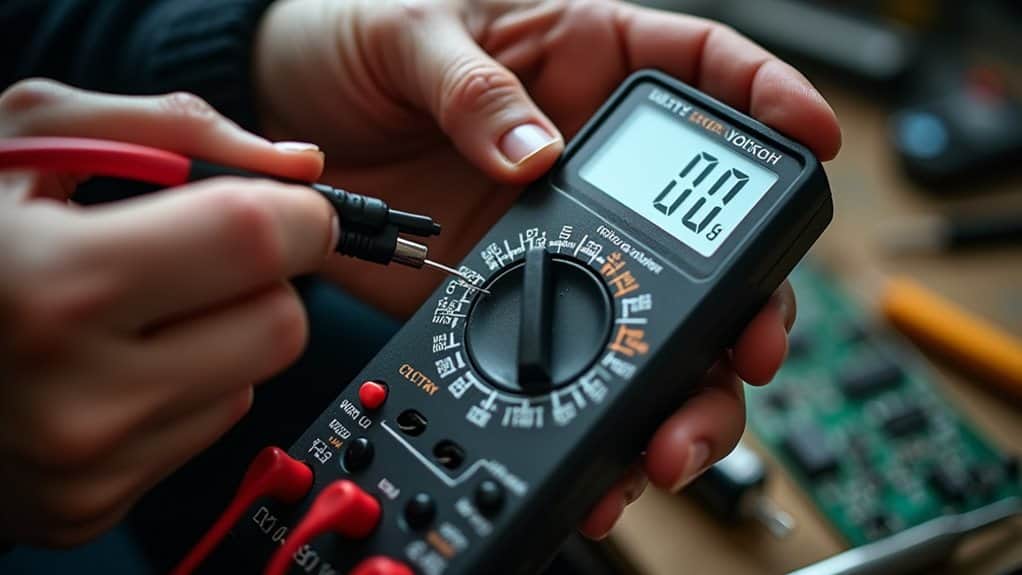To seal your aluminum boat for longevity, start by thoroughly cleaning surfaces with aluminum-safe products and freshwater rinses after saltwater exposure. Remove oxidation through systematic sanding, then apply marine-grade sealants like polyurethane for flexible areas or epoxy for structural repairs. Consider UV-resistant coatings such as Alumaclear, and implement monthly inspections for corrosion signs. Prevent galvanic corrosion using insulating materials between dissimilar metals, and maintain proper storage practices to minimize UV damage and environmental exposure for extensive protection strategies.
TLDR
- Clean aluminum surfaces thoroughly with marine-grade degreasers and sand mechanically to ensure proper sealant adhesion and effectiveness.
- Select appropriate marine sealants: epoxy for structural repairs, polyurethane for flexible waterproof seals in active areas.
- Apply UV-resistant coatings like Alumaclear or consider vinyl wrapping to protect against sun damage and saltwater corrosion.
- Inspect monthly for cracks, corrosion, and hardware issues, with quarterly fastener checks and annual professional inspections.
- Rinse with freshwater after saltwater exposure and tighten loose rivets to maintain watertight integrity.
Understanding Aluminum Corrosion and Vulnerability Points
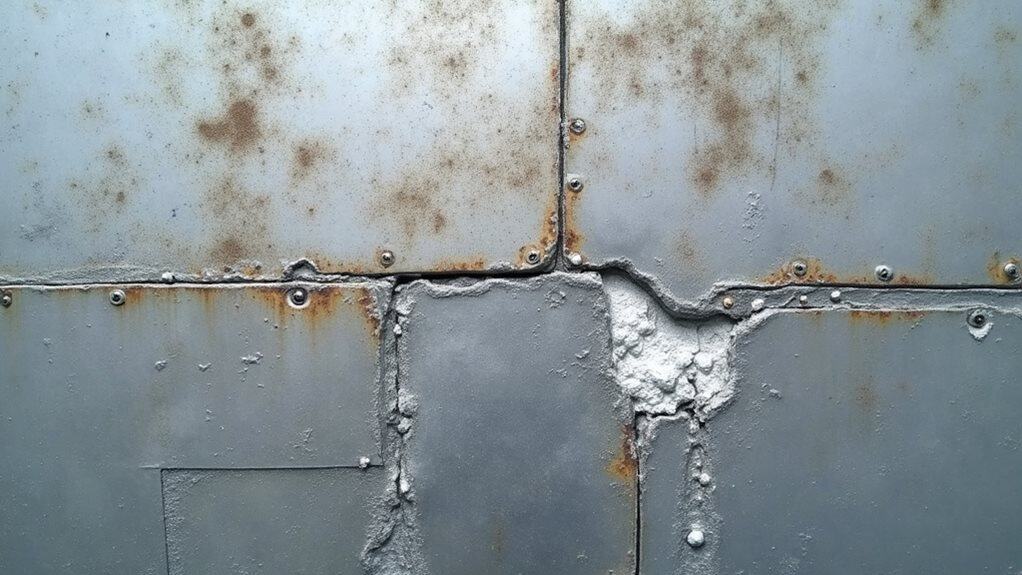
Before you can effectively seal your aluminum boat, you’ll need to understand the fundamental science behind aluminum corrosion and identify where your vessel is most vulnerable.
Aluminum naturally forms a protective oxide film, but saltwater, dissimilar metals like stainless steel fasteners, and trapped moisture in joints create galvanic and crevice corrosion that compromises this barrier. The conductivity of seawater significantly accelerates corrosion rates compared to freshwater environments, making proper sealing even more critical for boats operating in marine conditions. Additionally, understanding wildlife management principles can help you recognize how to maintain your boat in a manner that supports environmental conservation while ensuring its longevity.
Essential Cleaning Techniques for Aluminum Surfaces
Before you can effectively seal your aluminum boat, you’ll need to become proficient in the proper cleaning techniques that remove harmful contaminants without damaging the metal’s surface.
The key lies in selecting aluminum-safe cleaning products that won’t cause pitting or discoloration, while employing specific methods to eliminate salt deposits and tackle stubborn oxidation buildup. Soft bristle brushes are essential tools that allow you to scrub away contaminants without scratching the aluminum surface during the cleaning process. Additionally, it’s important to ensure that you choose aluminum-safe cleaning products to protect the integrity of the metal.
These essential cleaning steps create the foundation for a successful sealing process, ensuring your protective coating adheres properly and provides long-lasting protection.
Aluminum-Safe Cleaning Products
Choosing the right cleaning products makes all the difference when you’re maintaining your aluminum boat’s appearance and longevity.
You’ll want marine-grade cleaners specifically formulated for raw aluminum surfaces, like Captain’s Fury Aluminum Boat Cleaner or ZING® Marine Safe Aluminum Pontoon Cleaner.
These products effectively remove waterline stains, oxidation, algae, and barnacles without damaging your boat’s aluminum surfaces.
Salt Removal Methods
When saltwater exposure threatens your aluminum boat’s integrity, you’ll need targeted removal techniques that go beyond standard cleaning methods.
Use freshwater rinses immediately after each saltwater outing to prevent crystallization.
For stubborn deposits, apply white vinegar or specialized salt-away products, letting them dwell before scrubbing with soft brushes.
Regular flushing of internal systems prevents corrosive buildup.
Oxidation Cleaning Techniques
Although aluminum naturally develops a protective oxide layer, this chalky white buildup greatly diminishes your boat’s appearance and requires systematic removal to restore its original luster.
You’ll need aluminum-specific cleaners containing safe acids that foam upon contact with oxidation.
Use medium-red non-abrasive scrub pads with gentle, steady pressure to avoid scratching while effectively penetrating oxidized layers.
Proper Surface Preparation Before Sealing
Success in sealing an aluminum boat depends entirely on the quality of your surface preparation, which serves as the foundation for a watertight, long-lasting seal.
You’ll need to remove all contaminants with marine-grade degreasers, strip oxidation through mechanical sanding, tighten loose rivets, and create proper surface texture for ideal sealant adhesion and durability. Additionally, proper cleaning is essential as it enhances the effectiveness of the sealant and ensures a durable bond.
Selecting Marine-Grade Sealants and Protective Coatings
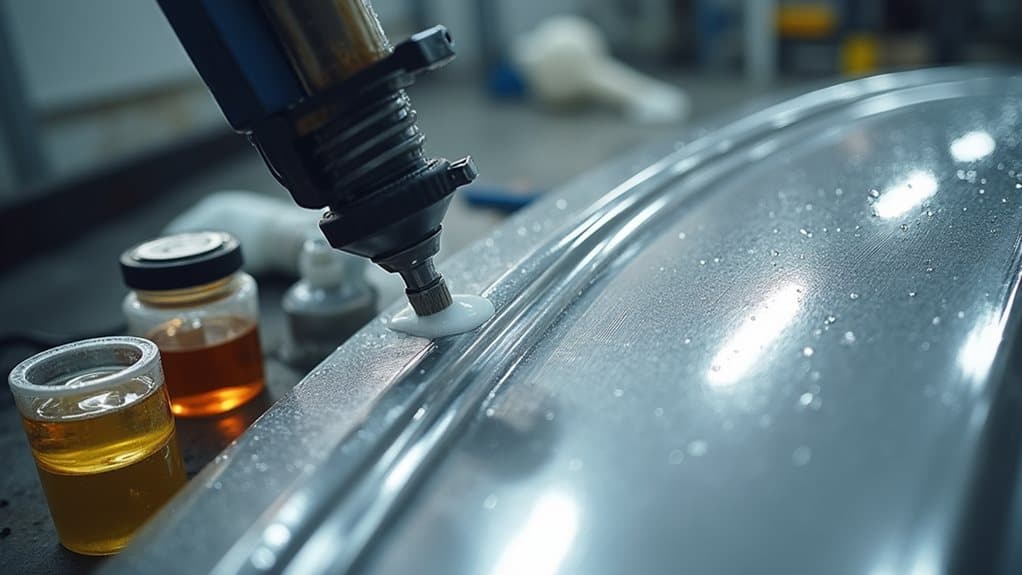
Choosing the right marine-grade sealant for your aluminum boat depends on understanding the different coating types available and matching them to your specific repair needs.
You’ll encounter three main categories: epoxy sealants that provide rigid, paintable repairs for structural fixes, polyurethane sealants that offer flexible waterproof seals for active areas, and specialized products like Marine GOOP that excel in adhesion and elasticity for high-stress applications.
Your selection criteria should prioritize adhesion strength to aluminum, flexibility to handle boat movement, and whether you need the sealant for above or below waterline use.
Marine-Grade Coating Types
Several marine-grade coating options protect aluminum boats from the harsh realities of saltwater exposure, each designed to address specific areas and challenges your vessel faces.
Clear coats seal aluminum pores, preventing oxidation and corrosion while maintaining appearance.
Polyurethane topside paints offer UV resistance and durability.
Bottom paints provide copper-free, anti-fouling protection against galvanic corrosion.
Sealant Selection Criteria
Beyond identifying the right type of coating for your aluminum boat, you’ll need to evaluate specific sealant properties that determine long-term performance in marine environments.
Prioritize flexibility and elasticity to accommodate thermal expansion without cracking.
Consider chemical and UV resistance for durability against fuel, cleaners, and sun exposure.
Make certain compatibility with aluminum and other boat materials for reliable adhesion.
Application Methods for Clear Coats and Transparent Sealants
Once your primer and base coats have fully cured, applying clear coats and transparent sealants becomes the critical final step that’ll protect your aluminum boat from UV damage, saltwater corrosion, and everyday wear. Regular cleaning helps maintain the appearance and effectiveness of these protective layers, just as cleaning frequency is important for RV awnings. Apply multiple thin coats rather than heavy ones to prevent runs and streaking. Maintain consistent spray distance, overlapping passes horizontally then vertically for even coverage.
Installing and Maintaining Sacrificial Anodes
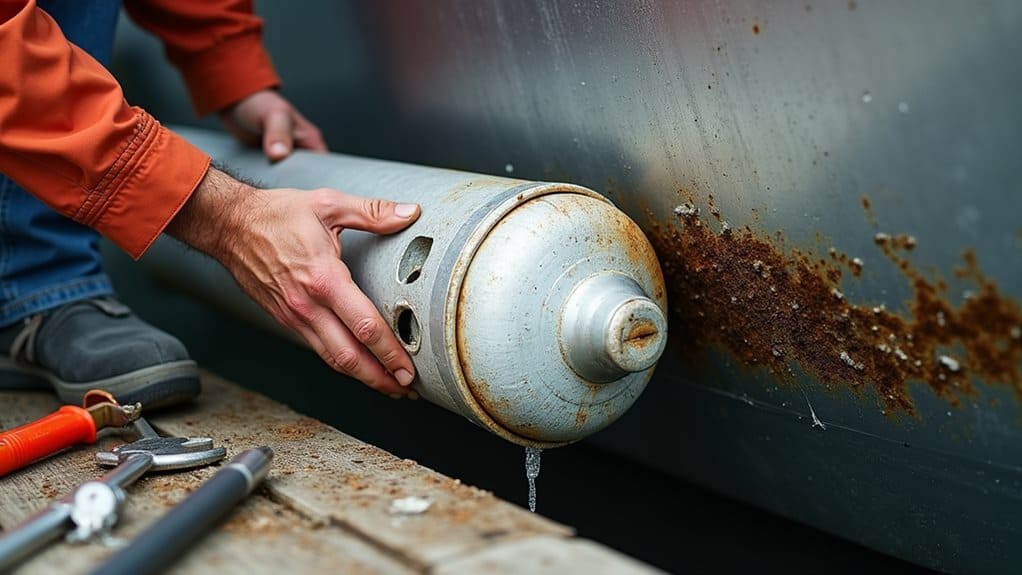
You’ll need to carefully select the right sacrificial anodes for your aluminum boat based on your operating environment, then position them strategically below the waterline for maximum protection.
Proper anode selection means choosing aluminum or zinc anodes for saltwater use, while avoiding magnesium anodes that can cause hydrogen embrittlement in your aluminum hull.
Once installed, you’ll want to establish a regular inspection schedule to monitor anode depletion and replace them before they’re completely consumed, ensuring continuous galvanic corrosion protection.
Anode Selection and Placement
Selecting the right sacrificial anodes for your aluminum boat isn’t just about picking the cheapest option—it’s about understanding how different metals interact with your hull and the water environment you’ll be traversing.
Choose aluminum or zinc anodes for saltwater applications, while avoiding magnesium anodes on aluminum hulls in freshwater due to hydrogen embrittlement risks.
Inspection and Replacement Schedule
Proper anode selection means nothing without a disciplined inspection and replacement schedule that keeps your aluminum boat’s corrosion protection system functioning at peak performance.
Inspect anodes every six months, checking for cracking, crumbling, or mass loss.
Replace them when they’ve corroded 50% from their original size, and increase inspection frequency in saltwater environments.
Preventing Galvanic Corrosion From Dissimilar Metals
When aluminum and stainless steel components come into contact on your boat, they create a galvanic couple that can cause serious corrosion problems, particularly in marine environments where saltwater acts as a highly conductive electrolyte.
You’ll need to break electrical contact using insulating coatings, non-conductive washers, or polymer sleeves around fasteners to prevent accelerated aluminum corrosion.
UV Protection Strategies for Aluminum Hulls
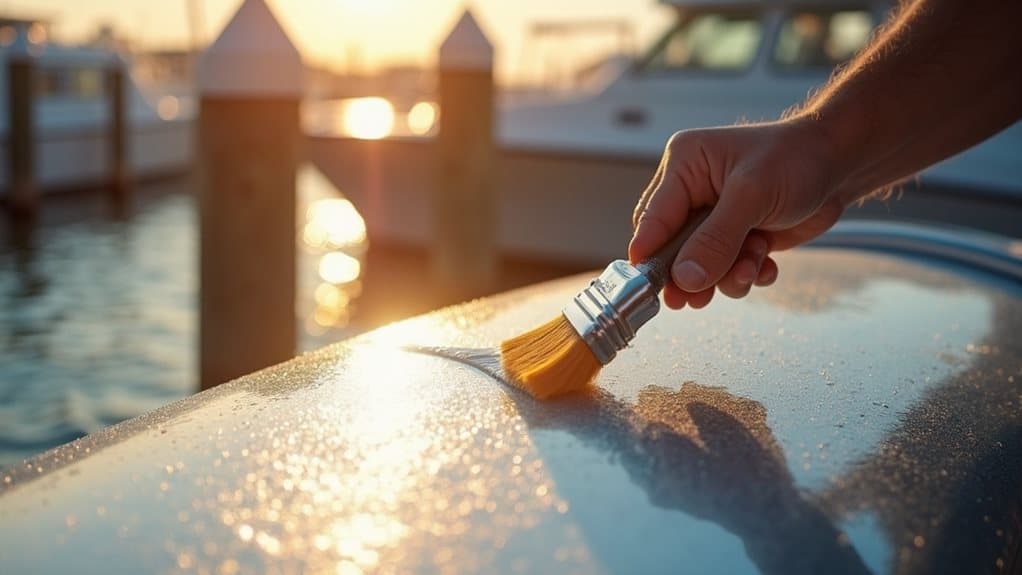
While aluminum naturally resists corrosion better than many metals, prolonged UV exposure can still cause significant damage to your boat’s hull through oxidation, surface chalking, and structural weakening.
You’ll need protective covers as physical barriers, UV-resistant coatings like Alumaclear, and specialized marine waxes.
Regular cleaning enhances these protection layers’ effectiveness, while proper storage minimizes cumulative damage.
Vinyl Wrapping as Additional Barrier Protection
Beyond traditional protective coatings, vinyl wrapping offers aluminum boat owners an extensive barrier solution that combines superior protection with aesthetic versatility.
You’ll get durable UV resistance, scratch protection, and saltwater corrosion defense while customizing your boat’s appearance.
Marine-grade vinyl costs less than professional painting, requires minimal maintenance, and removes cleanly without damaging your hull’s original surface.
Regular Inspection and Maintenance Schedules
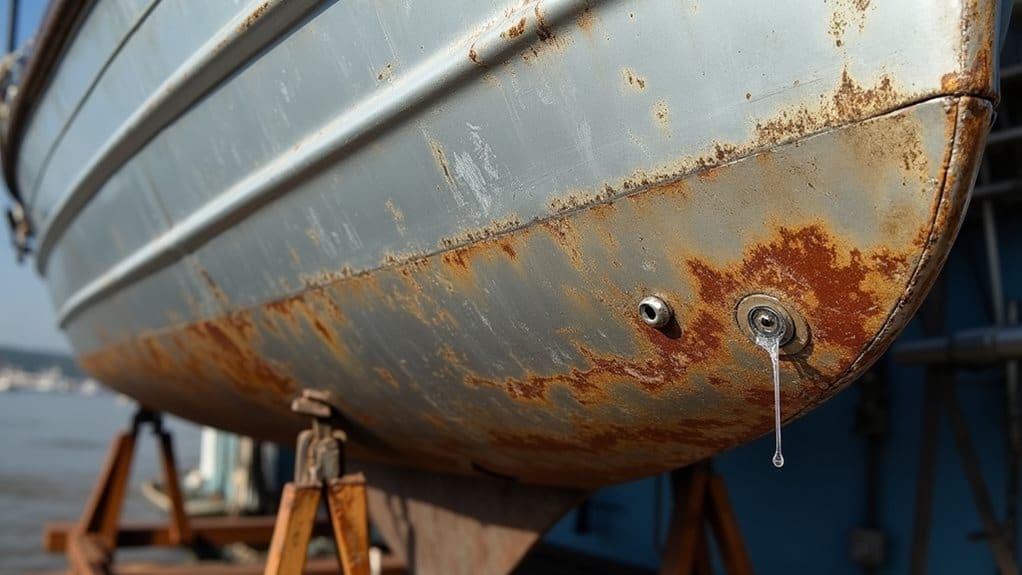
Three essential inspection schedules form the backbone of effective aluminum boat maintenance: monthly visual assessments, quarterly system checks, and annual professional evaluations.
You’ll inspect hulls for cracks, corrosion, and marine growth monthly, while checking fasteners and hardware quarterly.
Annual professional inspections verify weld integrity and system functionality, ensuring you’re maintaining proper records throughout.
Repairing Common Aluminum Hull Damage
When aluminum hulls suffer damage from impacts, corrosion, or fatigue, prompt and proper repair becomes critical to maintaining your boat’s structural integrity and watertightness.
You’ll need to grind damaged areas flat, chemically treat surfaces to remove corrosion, and drill out crack ends beyond visible damage.
Use marine-grade epoxy fillers for small holes and aluminum patches for larger damage.
Long-Term Preservation and Storage Practices
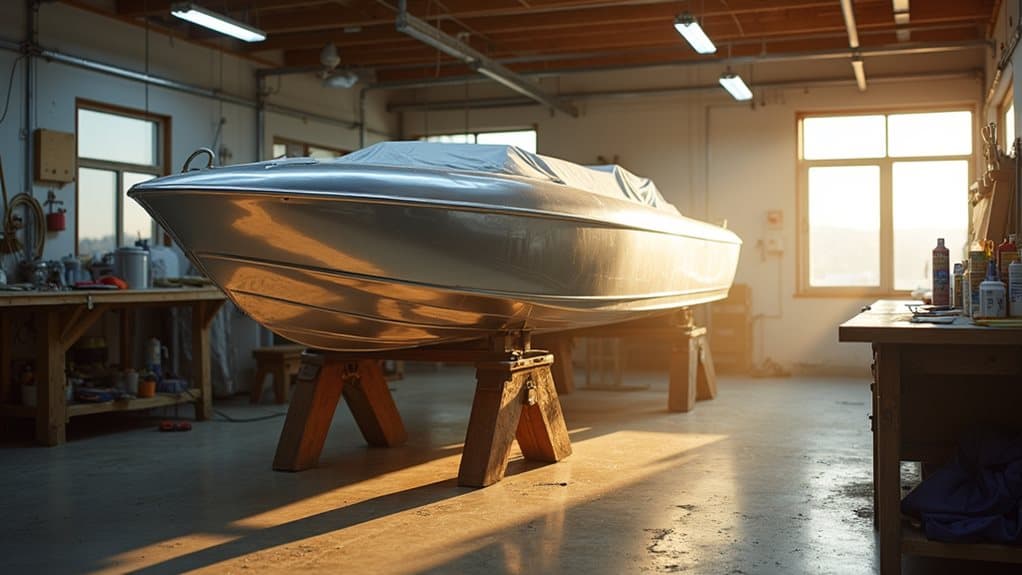
After addressing immediate damage issues, maintaining your aluminum boat’s longevity requires implementing thorough preservation strategies that protect against the gradual deterioration factors threatening your investment.
Proper winterization includes dry docking and covering your vessel to limit moisture exposure.
Store your boat in well-ventilated, dry locations while maintaining low humidity around stored vessels to prevent oxidation and corrosion buildup.
Final Note
You’ve now learned the essential steps to protect your aluminum boat from corrosion and extend its lifespan considerably. By following proper cleaning techniques, surface preparation, and applying quality marine-grade sealants, you’ll maintain your vessel’s integrity for years. Don’t forget to establish regular inspection schedules and address damage promptly. With consistent maintenance and proper storage practices, your aluminum boat will provide reliable service and retain its value throughout countless excursions on the water.


